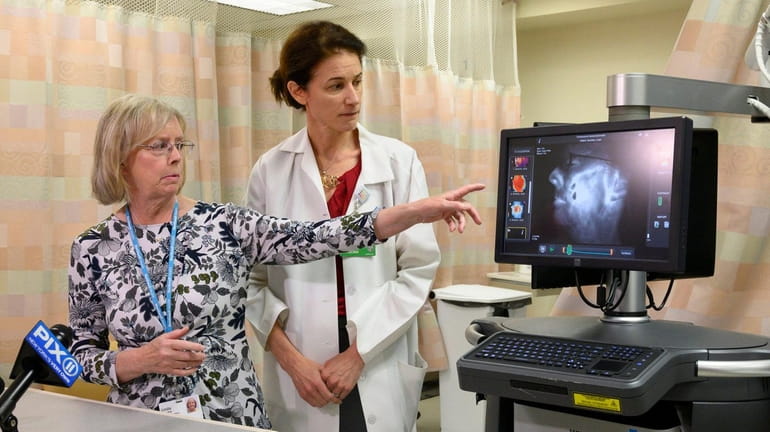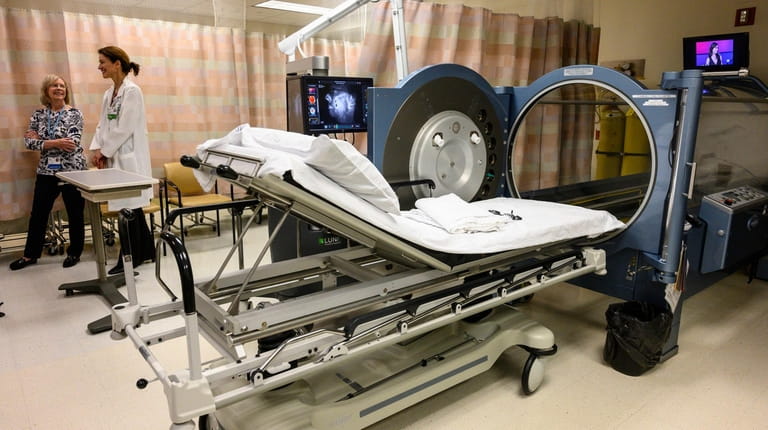Cleft palate nurse gets unusual treatment for her own facial deformity

Linda Dunckley, left, and Dr. Alisha Oropallo, director of the Wound Care Center at Northwell Health, discuss the hyperbaric oxygen treatments used on Dunckley. Credit: Newsday/Alejandra Villa Loarca
Most of Linda Dunckley’s time is devoted to caring for patients with severe facial deformities, but after a small spot on her own cheek became a two-and-a-half-inch hole, it was time to care for her own.
Dunckley, a nurse for 45 years, grew up in Garden City, spending her summers at Jones Beach and her family’s house on Candlewood Lake in Connecticut. Despite countless hours of water skiing and playing volleyball, her summer thrills were missing one thing: protection from the rays above.
“I was born in ’53,” Dunckley said. “How many people were using sunblock back then? Probably very few.”
Dunckley's job made her familiar with the dangers of suspicious changes on one’s skin. It moved her to get a skin biopsy when she noticed a strange spot on her left cheek in late 2018. She tested positive for basal cell carcinoma, a common type of skin cancer, which is generally treatable.
Dunckley had the cancerous cells removed through Mohs surgery, a procedure that requires tissue layers to be removed from the skin and examined under a microscope continuously, until no further cancer cells can be detected, she said.
But by the time a plastic surgeon had completed Dunckley’s tissue removal, there was a hole left in her face, about two and a half inches wide.
With such a large wound, Dunckley needed an operation to close the opening.

Linda Dunckley and Dr. Alisha Oropallo in a hyperbaric oxygen treatment room. Credit: Newsday/Alejandra Villa Loarca
Dunckley, who now resides in Setauket, is familiar with facial reconstruction. For the past 18 years, she's been the nurse coordinator at Northwell's Hagedorn Cleft Palate and Craniofacial Center in Great Neck and often works with children born with clefts and other craniofacial anomalies from the neck up.
A skin graft would surely take care of her problem, she thought.
But it didn't happen. Two small sections, each about a half-centimeter deep and one inch wide combined, remained unhealed on Dunckley’s cheek. It didn’t matter which restorative creams or ointments she used.
“I didn’t really stop my life over it," she said. "I had a bandage on my face, and I went to work every day."
Still, Dunckley decided to visit the Northwell Health Comprehensive Wound Care Center, where she received an unusual, but ultimately effective treatment — hyperbaric oxygen therapy.
During this treatment, 100 percent pure oxygen is given to patients via hyperbaric oxygen chambers, which are clear, pressurized tubes that fit a patient on a narrow, reclinable hospital bed — similar in appearance to an MRI but smaller.
Breathing pure oxygen at an increased atmospheric pressure speeds up the recovery time of a patient's wounds, said Dr. Alisha Oropallo, who treated Dunckley. Blood carries hyperbaric oxygen through the body, fighting bacteria as the oxygen directly enters the affected tissue areas, she said.
The therapy is typically used to treat the wounds of diabetic patients with foot ulcers. It's rarely done for nondiabetics.
“She had failed a lot of different modalities of treatment — common modalities — and there wasn’t much of a choice left,” Oropallo said. “We either leave her with a hole in her face, or we move forward with some adjunctive therapies to try to heal her wound.”
Dunckley underwent treatment for two hours a day, Monday through Friday, over a span of six weeks. She got 30 treatments overall.
They went by quickly, she said, adding that she could drink water, watch movies or television, or take naps throughout her sessions.
Oropallo said the success of the treatment points to a future of hyperbaric oxygen therapy beyond the realm of diabetes.
“People should realize that there are other alternatives out there, including hyperbaric oxygen treatment, to help heal those wounds that are very difficult to heal,” she said.
Other conditions that can be treated by hyperbaric oxygen therapy include decompression sickness, air bubbles in blood vessels, radiation injuries and serious infections, according to the Mayo Clinic.
Dunckley said in her mid-20s, she started applying sunscreen, but since finding the cancerous spot — she takes it even more seriously. Her makeup has SPF 50 and she wears it daily, even throughout the winter. She warns others, as well: "They should be very careful, themselves."

Updated now Newsday travel writer Scott Vogel took the ferry over to Block Island for a weekend of fun.

Updated now Newsday travel writer Scott Vogel took the ferry over to Block Island for a weekend of fun.
